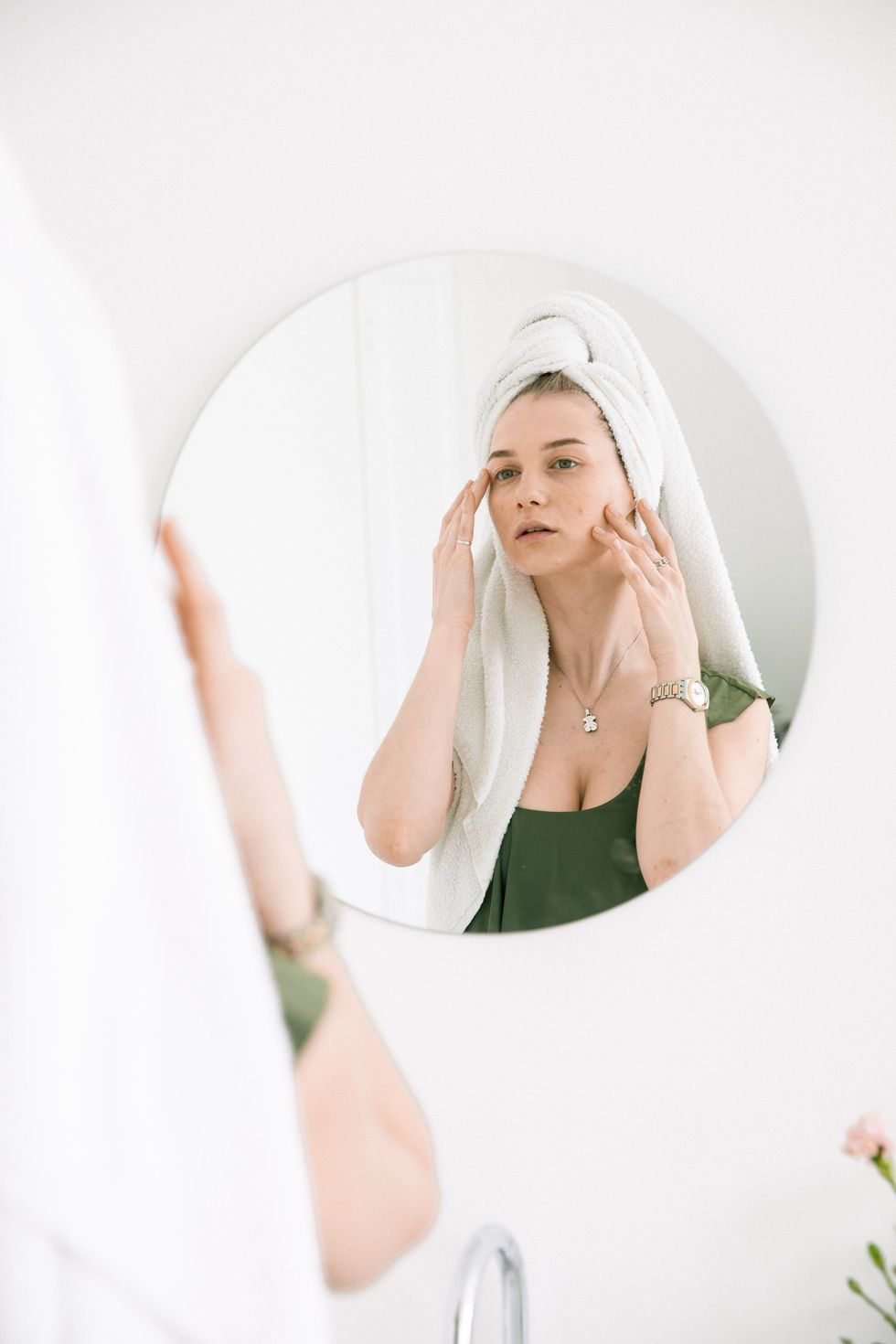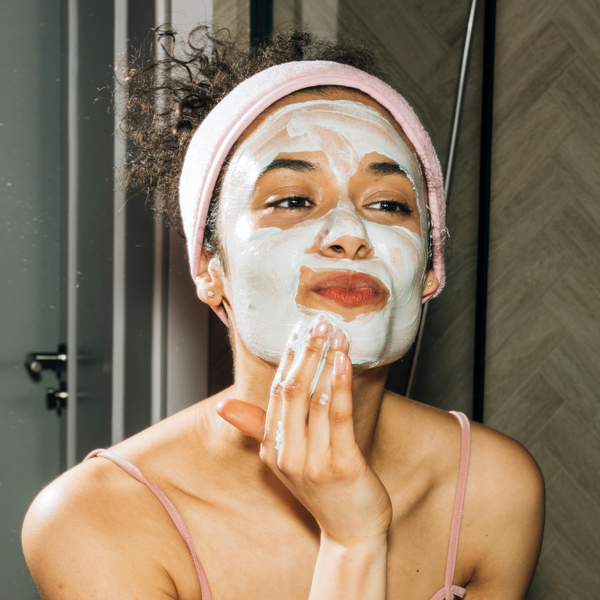Nuture your face + body with an easy lymphatic drainage massage.
How To DIY A Lymphatic Drainage Massage For A Transformative At-Home Facelift

Meredith Holser is the Shopping Editor at Brit + Co, covering everything from seasonal fashion trends and the best grocery finds from Trader Joe's to shoes actually worth splurging on and life-changing beauty products. Outside of work, you can catch Meredith hiking, trying new recipes, and dreaming about having a yummy little treat.
I'm bombarded by a new skincare trend just about every week, courtesy of #SkincareTok. Recently it's been videos of girlies using gua sha and face rollers on their hyper-hydrated faces. My instincts told me that this form of self care had to be good for you, but I simply wasn't invested enough in the routine practice...until recently. I learned that just about every interaction of the facial massage on my FYP is known as lymphatic drainage, and it's productive at removing toxins, improving circulation, and rejuvenating your skin. You can do even more good drainage work with a full body massage, if you really want to commit. Let's dive in to the practice, what it does specifically, and how you can do it yourself!
What is the lymphatic system?

Photo by EKATERINA BOLOVTSOVA / PEXELS
The lymphatic system is a group of organs, tubes, and lymph nodes that produce, store, and transport white blood cells. Its framework is similar to the circulatory system, but in this case, it carries lymph instead of blood. Lymph fluid is made up of white blood cells that destroy abnormal cells. "This network of vessels and nodes helps to filter out toxins, waste, and other unwanted substances from our tissues and organs, helping us to stay healthy and disease-free," says Lesley Thornton, founder of KLUR skincare.
What is lymphatic drainage?
Sometimes your lymphatic system can experience blockages of fluid – lymphatic drainage is the practice of essentially removing them. The lymphatic system cannot move independently, so facilitating movement is essential. Gently massaging the system relieves pain and swelling associated with blocked vessels.
"Lymphatic drainage can be done using a few different methods, but the most common approach involves gentle, rhythmic massage strokes that follow the direction of lymph flow," says Thornton. You can hone in on specific parts of the body, from your stomach, to your neck and face.
What are the benefits of lymphatic drainage?
@janell.roberts How to manually drain your lymphatic system at home #lymphatichealth #fypシ゚viral #bettersleep #managestress #lymphaticsystem #betterhealth ♬ Piano Love - TonsTone
Lymphatic drainage can reduce swelling and puffiness, improve blood circulation, boost your energy, increase your immune function, decrease bloating, and relieve lymphedema and congestions. Facial lymphatic massages detoxify the skin, promote relaxation, and improve signs of aging like wrinkles. The practice can even give you a soft “facelift” effect by improving your overall blood circulation.
"Doing lymphatic drainage over the years has helped me with bloating and digestion, puffiness, smoothing the skin on my legs, and my energy levels," says Dr. Lindsey Schmidt, Board Certified Doctor of Chiropractic, who's also passionate about educating women about their overall health. Her journey with lymphatic drainage has helped her really feel a difference.
"[Lymphatic drainage] has helped my mental clarity so much," says Dr. Schmidt. "Physically, I feel more confident, because it’s helped so many areas of my body, from face puffiness to the constant bloating I dealt with."
How do you know you need to drain your lymphatic system?
If you're noticing signs of swelling and puffiness, it may mean that your lymphatic system needs support, says Thornton. All of these signs also suggest blockages within your system:
- Fatigue or low energy levels
- Frequent illness or infection
- Joint pain or stiffness
- Digestive issues, such as constipation or bloating
- Skin conditions, such as acne, eczema, or psoriasis
- Headaches or migraines
- Brain fog or difficulty concentrating
- Puffiness in the neck, above the collar bone, or fingers
- Swollen ankles and behind the kneecaps
How can I practice lymphatic drainage?
It's generally recommended that you get lymphatic massage treatments once every 4-6 weeks. If you are experiencing more frequent concerns, you may opt for a more frequent practice. Results and relief are typically noticeable after a few sessions, so just keep at it. To do an at-home lymphatic massage, try following a video tutorial like the one above, or move through these steps:
For a full-body lymphatic massage:
- Take a moment to breathe deeply. Aim for a deep belly breath, breathing in through the nose, and slowly out the mouth. Taking this time to settle in and relax your body promotes lymphatic drainage.
- Use your index and middle fingers on each hand to gently massage the sides of your neck, moving down toward your collarbones. Avoid pressing too hard, as pressure can disrupt lymphatic flow.
- Move your focus to the sides of your neck just below your ears. Massage in the center of the back of your neck, then follow the movement down toward your upper back. The entire movement should resemble an "L" shape.
- Massage the underarms, transitioning this movement toward the center of your chest.
- Next, move to the hips, focusing on bringing the massage movement up from your hip bones to your underarms.
- Once you've completed that step, begin focusing on your legs, moving the lymph fluid down to the toes. If your toes swell, massage the fluid back up into the lower leg.
- Grab any facial tools you may need. Tools like gua sha stones, brushes, and jade rollers are recommended, but not absolutely necessary. Your hands will do fine!
- Lather on a skin-friendly oil or lotion to lubricate your neck and face. This will help facilitate gentle movement and avoid you pulling any sensitive skin.
- Focus on using upwards and outwards motions for each part of the face. Begin by gently massaging the neck with the index and middle fingers, massaging up and out. Take care not to apply too much pressure, as you want to be gentle with your skin.
- Think about kneading your cheeks upward toward your eyes, then move out toward your hairline.
- Practice these gentle movements to trace your jawline and cheekbones for a contoured look.
- Spend about 10 to 15 minutes massaging your face. Once you finish, rinse off the excess oil or lotion you used. There you have it – an easy at-home facial lymphatic message.
Can anyone practice lymphatic drainage?
Thornton encourages everyone to try out self-massage. Though you can perform lymphatic drainage methods at home, "a trained esthetician or massage therapist can perform advanced techniques and treatments that may be more effective and provide more comprehensive results," she says. If you feel your practice needs assistance, don't hesitate to explore your options for a local esthetician or massage therapist.
Lymphatic drainage is not a one-size-fits-all approach. "Factors such as your age, lifestyle, and overall health can all impact the frequency of lymphatic drainage treatment," Thornton says. "Therefore, I suggest working with an expert who can make personalized recommendations based on your unique skin concerns and goals, helping you determine the ideal treatment frequency for your needs."
What to do after a lymphatic drainage massage?

Photo by Pavel Danilyuk / PEXELS
After-care is essential when practicing lymphatic drainage. Ensure you are taking in enough water to stay hydrated after the fact – it can support lymphatic flow throughout the face and body. Thornton recommends finishing off your massage with a gentle cleanser and hydrating moisturizer to protect the skin from irritation. In addition, aim to get a good night of sleep and continue to monitor your stress levels.
Sign up for our newsletter for more beauty tips!
Header image by Ivan Samkov / PEXELS



















